We’re standing in a thick blizzard. Tree’s surround us and visibility is down to 50 feet at best. Not a sound can be heard, except the one that sends a shiver down my spin, the distant howl of a wolf calling out to the rest of the pack. Are we about to finally encounter the one species that had evaded us the whole trip?
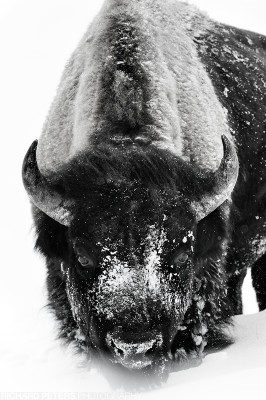
Snowy Bison, mono
The final part in my Yellowstone trip report carries on where Part Two left off, and covers the final few days in the park where plus a few fun facts about the trip, for those that might be looking to do something similar.
DAY SEVEN: THE WIND
Today we said goodbye to Steven, Art and Jamie. They came out with us for the first few hours in the park before they had to head back to the hotel, pack up and leave. It was a shame to say goodbye as we had a great laugh with them, and from the looks on their faces they didn’t really want to be leaving either. But would you?! Rene, Hans and myself headed deeper in to the park, driven by Dale, as the others headed back in the direction of the hotel, and more depressingly Bozeman and the airport, with Dales son.
It was very windy today. The windiest it had been all trip, and with that wind came the wind chill factor. I swear it felt colder today than any other day so far, even though it was a moderate -15 or so. We happened across a fantastic bison, which had slept through the heavy overnight snow and was completely covered in a blanket of the white stuff. So much so that at first we thought it was just a snow covered rock, it blended in so well with the surroundings.
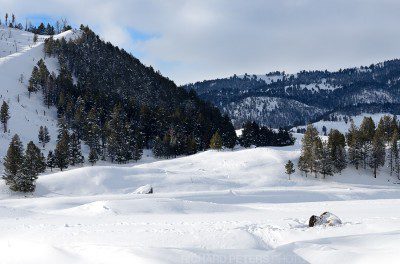
A snow covered bixon becomes one with the scenery
We pulled up along the roadside, under the cover of a tree and sat waiting, hoping that the bison would stand up and shake off all that snow. We were at a disadvantage as the wind was blowing towards us, constantly covering us in the fine powdery layer that sits on top of the deep stuff. The tree we were under was also covered in snow, and every time there was a large gust of wind, a shower of loose snow would drop down on us. It’s fair to say the bison clearly had way more staying power than we did, so after 20 minutes or so we decided watching this sleeping giant wasn’t getting us anything other than battered by snow and wind. So I took a couple of close up shots to go alongside the environmental images.
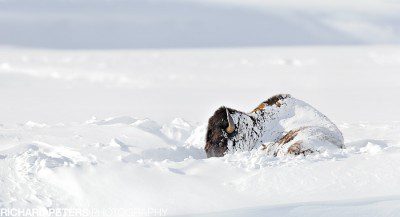
A bison sleeps so long, that a snow blanket is formed
Due to the proximity of the bison I was stuck between a wide angle and my telephoto so yet again had to do a panoramic image stitch of several frames using the 600mm. It works well though I think, even if it doesn’t convey just how windy it was (because I know what you’re thinking, it looks so peaceful in the photos. Trust me, it wasn’t!)! A relatively quiet day other than that.
No wolf sightings yet.
DAY EIGHT: PINE MARTENS
What a fantastic day! We spent it photographing Pine Marten and various species of birds at a location seldom known to outsiders. It’s an area so ripe in Pine Marten activity that BBC film crews have been there to film them.
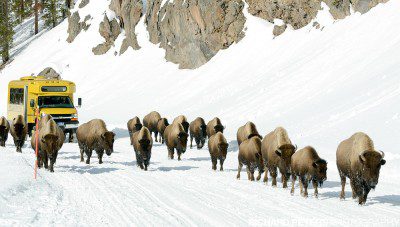
Bison like using the roads as they are easier to walk on
Although, we did encounter a traffic jam along the way. Something I’ve not mentioned before, just because you don’t see another car on the road for half an hour sometimes, doesn’t mean you don’t find congestion once in a while thanks to the bison which find walking in the road easier than the thick snow covered fields.
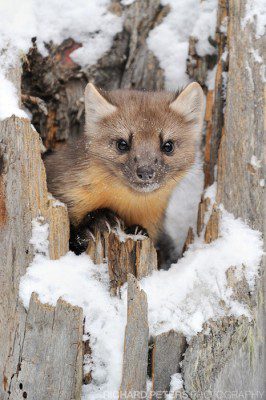
Nikon D3s, 70-200 + 1.4x
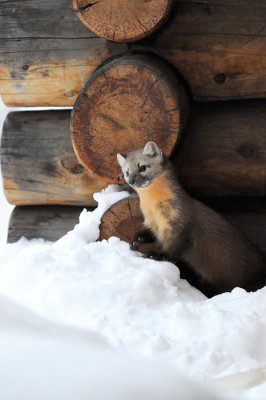
Nikon D3s with 70-200
You can read more in depth about our day spent photographing the pine martens and see many more images of them in my previous blog post about them, here.
No wolf sightings yet.
DAY NINE: MY MOST MEMORABLE MOMENT
Our final full day in the park and what a great day to end the trip on. First up, I managed to spot a rarely sighted bird in the park, the Great Grey Owl. We were chatting away driving through one of the forested areas of the park and I, as usual, was staring out the window in the hope of spotting something to photograph. I had been admiring a lovely Great Grey Owl image the day before taken by photographer Dan Hartman, and so they were fresh on my mind, and then there it was. I caught a flash of those intense eyes out the corner of my eye and shouted for the car to stop. We reversed back and everyone scanned the tree’s trying to find this elusive bird. And there it was. Perched perfectly atop a tree, staring straight at us. We fumbled for our cameras as Dale slowly reversed the car back a little more. Of course, just as the owl became visible in our viewfinders through the gaps in the tree’s, it took flight! Still, what a pleasure to see such a magnificent bird, and what I great start to the day.
That was followed by photographing some bison, in more high winds. The thing that is incredible about Yellowstone in the winter months, is that in the space of 5 miles the temperature can fluctuate by a good twenty degrees and the weather can go from calm to windy, to sunny, to cloudy. Were as the morning had started off calm, we now had wind and almost blizzard conditions again. Both us and the cameras got pretty snow covered, and visibility dropped down and mini white outs kept happening as the fine snow got whipped up off the floor creating an almost low level fog. And with the snow being blown around came a very large amount of natural light being blocked out. We had to park some way back from the bison as you can see from this image below which Dale took of me, walking down the road to where the bison were grazing. With tripod over one shoulder and 600mm in the other hand I was getting blown about all over the place. Notice how you can’t even see my legs or the lens. You could brighten this image up, but then it wouldn’t reflect the bitter cold conditions and light levels as they were at the time!
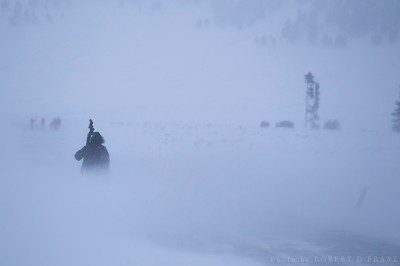
Me, walking back down the road in harsh windy conditions
The walk was well worth it though because we got some lovely images of the bison in the harsh conditions as the snow fell from the sky, and the fine powdery snow got whipped off the ground creating a snowy fog. Quite brutal and definitely one of the most physically intense experiences of the trip.
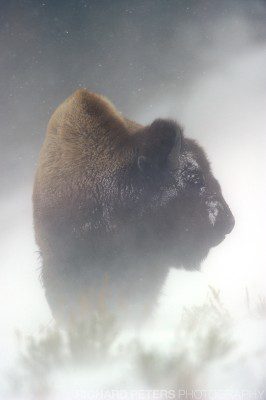
A bison braving the harsh, snowy, wind swept weather
Later, after the bison had moved on, we made our way through Lamar and only saw the very distant coyotes we normally see. Up ahead we could see the weather was turning for the worse and before long the heaviest blizzard of the trip had rolled in. A bit further up the road near Pebble Creek we were flagged down by two photographers. They had recognised Dale and wanted to tell him there was a wolf nearby. Sure enough we got out the car and listened. It was a moment I’ll never forget, and I’ll admit it sent a shiver down my spin. There it was, with thick tree’s all around us and even thicker and heavier snow falling from the skies we heard it, the distant sound of a wolf howling out to the rest of the pack. Visibility was down to maybe fifty feet at best so we had no chance of trying to spot the wolf but it didn’t matter, it was an unforgettable moment, filled with atmosphere and it truly summed up what Yellowstone in winter is all about. We drove the road up and down several times in the hope of spotting the one animal that had eluded us the whole trip. But we just missed out, as we found out the wolf had crossed the road twice whilst we were looking for it, but neither time did we see it. It was great to at least hear one though, and to know we came close was nice, as apparently there had been very few close encounters since October the previous year!
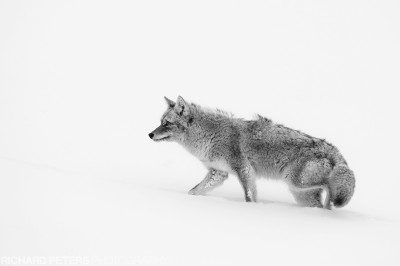
A coyote battles the wind and snow covered floor
With the weather really closing in during the late afternoon the park was once again empty of all signs of life as we made our way back to base. But then right near our hotel we spotted several cars parked up and a group of photographers pointing big lenses up at the hillside, and there we saw a coyote eating a weasel. The weather was truly awful with wind and snow blowing about and thick foggy cloud blocking what little daylight remained. However, we got some shots off of what turned out to be our closest coyote encounter of the trip. And a great way to end our final day in the park. As you can see, with such dull light, I opted for a black and white conversion of the image, which suited it nicely – although again, other than the wind swept fur on it’s back, it is quite hard to tell how harsh the conditions were!
We heard a wolf!
THE FINAL MORNING: A QUICK SCOUT OF THE LOCAL ROADS BEFORE LEAVING
We were all packed up so just spent a couple of hours on the roads outside the park. We spotted our final coyote of the trip running along a ridge line near the entrance to the park, with the cloud covered distant mountains in the background.
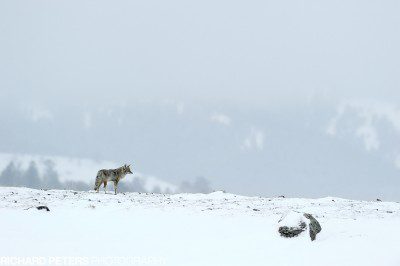
A coyote walks along a ridge line near the park entrance
Not much else about so we decided to call it a day and head back to the hotel to pack the camera gear and drive back to Bozeman and begin the long journey home to the UK. A golden eagle circled the hotel as we pulled away, nice that it came to see us off.
THAT’S NOT QUITE ALL FOLKS…
So, I hope that made for some fun reading. But I’m not done just yet! I thought I’d throw in a few little extras as well. So to start off there are a few facts and info about the trip to give those thinking about doing this an idea of what to expect, followed by some thank you’s and then my summary of the experience. Last but not least you’ll find a few extra images at the bottom of the page!
FACTS AND INFO ABOUT OUR YELLOWSTONE TRIP
8000: the average distance we spent in feet, above sea level.
1044: the very conservative number of miles we drove in the park. Google maps tells me it’s 116.2 miles from Gardiner to Cooke city and back. A journey we did every day. But that doesn’t include the amount of times we turned round and went back and forth on top of that, I’d estimate it was closer to 700 miles.
20: The travel time in hours to get from the departure gate at Heathrow T5 to the hotel room in Bozeman
9: The number of full days spent in the park
5: The deepest amount of snow I encountered in feet, using my Gitzo as a make shift measuring device!
4: the number of flights needed to get from the UK to Yellowstone and back. Heathrow to Denver with British Airways then Denver to Bozeman with United. Roughly a 4 hour stop over at Denver, both outbound and inbound.
2: The number of hotels we used. The Comfort Inn in Bozeman and the Super 8 in Gardiner
1: The amount of cars we saw that had slid in to deep snow filled ditches at the side of the road and had to await park rangers to be towed out.
Getting around:
We had two 4×4 GMC Surburbans. The roads are covered in snow and ice, without a 4×4 you aren’t going anywhere. Also handy for those times you need to pull over a little to let oncoming traffic out the way.
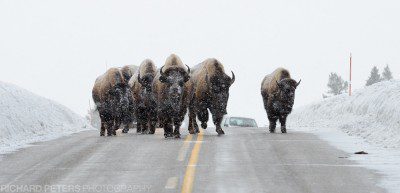
You need to take care when driving the yellowstone roads in winter
Who the trip was run by: A big thank you to our host, professional wildlife photographer Robert Dale Franz. Both he and his son were very friendly, funny and knowledgeable. Given that Dale lives just outside the park and spends almost as much time in it, as out of it, I can’t think of anyone else I would rather have been led through the park with.
Clothing
You need the right clothing to photograph in Yellowstone during the winter. Without it you simply can’t leave the hotel. Get cold or wet and you will very quickly have to stop photographing and instead try and get warm, and it’s almost impossible to dry off without getting back to the hotel. It’s a dangerous place to be if you aren’t prepared!
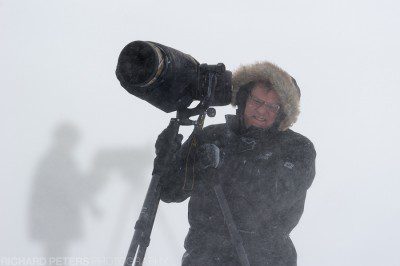
Rene battles with the wind and snow to get his 600mm in position
Here’s a quick rundown of the clothing I picked up to help keep me warm:
Haglof Atom bib trousers made of Gortex Pro, two pairs of merino wool thermal long johns (two different thicknesses) and 2 pairs of merino wool knee high socks from Woolpower, two semi synthetic ‘wicking’ base layers, an Under Armour balaclava, one thin thickness fleece, plus a medium Woolpower fleece plus a Jack Wolfskin ultra warm fleece. Two different types of gloves, one a mitten style and one a traditional style rated down to -60, plus thin merino wool fingerless inner gloves. Finally, a trappers hat from North Face, a down filled hooded parka from Jack Wolfskin and Baffin Apex snow boots rated down to -140!
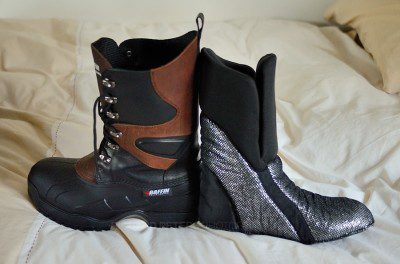
The Baffin Apex with removable inner boot. Warmest boots ever.
I basically had to wear various combos of all that each day. The warmer days I could wear my thin long johns with the Gortex trousers in top, on the very cold days I had to wear both pairs of long johns under them, needless to say using the outside toilets dotted around wasn’t the easiest thing when wearing ALL the gear on the coldest days. And I won’t even begin to tell you about the horror of seeing what had frozen solid down the sides of those toilets (lets just say, if ever you needed to concentrate on your aim gents, it’s in an outside toilet at -39 in Yellowstone!). The two best investments were the down parka and Baffin boots. Both worked fantastically at keeping my body warm and my feet dry. The faux fur hood on the parka was excellent at cutting out the wind noise too. With the socks, I only had the two pairs for the entire trip! If you get good quality ones that have anti bacterial agents you can wear them for quite some time before they smell (apparently the record is held by a soldier in the army that wore one pair for 70 odd days straight!).
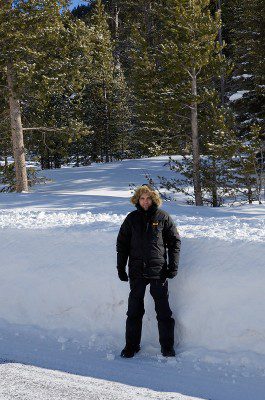
All six foot of me next to some of the deep snow
How did the cameras operate in the extreme weather?
At this stage, some of you might be wondering how the camera gear operated in this cold weather. Both the D3s and the D7000 had performed flawlessly so far in the extreme cold, despite Nikon’s maximum low temperature rating of only 32f or zero Celsius (which seems a little odd to me). Even the batteries held up very well. Of course you need to take in to account that we weren’t taking thousands of images a day here but even so, I hadn’t once returned to the hotel at the end of the day with anything under around 70% of power remaining for either camera. Although, I did always make sure the batteries were fully charged each night just to be on the safe side, and my spares were always kept in an inside pocket close to mu body to keep them warm when we were out in the field. My Gitzo and Wimberley MKII did well, although the Gitzo legs kept freezing in position. The reason being, I’d put my tripod down in deep snow, then when I pulled it back out again the snow had frozen solid around the leg locks. Very awkward at times as I’d have to try and get the tripod back in the car with the legs extended at varying lengths! Another thing that I have to point out, is that between the lenses I was shooting with, the 600mm, 70-200 and 14-24, I had to make sure I either held them with gloves on, or where they were wrapped in a Lens Coat. The metal parts of these lenses are just untouchable when it’s this cold. Sure you have gloves on a lot, but there a lot of times you need to take them off. I can’t stress enough that if there is ever a time you need to have your Lens Coat or similar product of choice on, it’s in the deathly cold valleys of Yellowstone in the middle of winter!
THANK YOU
I’ve just got to say thank you to a couple of people before I wrap this up. Firstly, thank you to my buddy Rene de Heer for doing all the organising of the flights to and from the USA and the initial contact with our host. Both he and Hans were great fun on the trip (especially Hans and his eternal quest for chocolate milk and rice at every restaurant we went too), which I think helped keep us going in some of the quieter periods!
All the members of the group were great company to be shooting with, unfortunately only one off whom I know has a website and he also supplied a couple of the images here of me. So thank you Steven Berkowitz. I very nice chap who I hope to have the pleasure of shooting with again someday.
Finally, thanks again to Matt for letting a strange Englishman he’s never met before send a pair of boots to his house, then deliver them to said Englishman at his hotel, instead of keeping them for himself!
YELLOWSTONE IN WINTER: A MUST FOR ANY WILDLIFE PHOTOGRAPHER!
So there we go, that was my first trip to Yellowstone, documented in detail. If you’re intrested ni visiting this amazing place I hope you found the three part article interesting to read. If you found it too much to take in, I hope you at least enjoyed viewing the images! 🙂
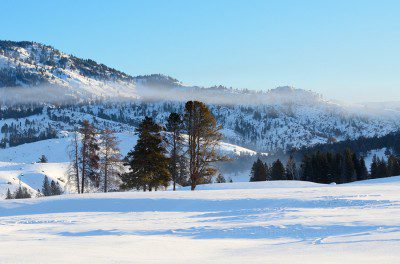
Low afternoon light casting shadows on the snow
I’ll be the first to admit, we saw a lot less wildlife than we had hoped for other than bison – which is why there are a fair few images of them in this write up! As I mentioned, everyone we had bumped in to on the trip had said what a quiet season it had been. What helps make YNP such a spectacular place in winter was also the cause of this lack of wildlife. The 2010/2011 winter had seen some of the heaviest snowfall in seven years, and as a result pushed much of the wildlife out of the park and to lower elevations where the snow wasn’t as thick on the ground. Dale, and several members of our 8 strong group had had trips here before where there we almost photo ops all day every day. It’s just the luck of the draw, and a reminder that there are no guarantees with wildlife, even if you fly thousands of miles from home to find it. There were places where the snow banks literally sat higher than the car, so you couldn’t even see the fields and immediate valley floors close to the road as you drove along. I’m 6 foot, and you can see one of the ‘medium’ sized snow banks here. So with snow that deep, smaller wildlife didn’t have a chance of getting about in the open!
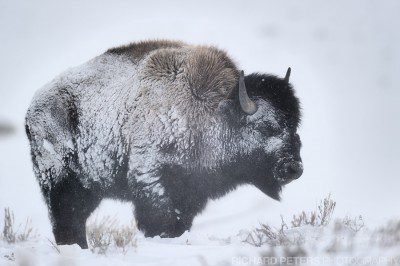
The D3s & 600mm held up well photographing in these conditions
We did get some nice images though, there is no denying that. And with the snow acting as a giant reflector, unless there was low laying fog or cloud, even overcast days provided a nice even light which allowed us to make the most of the opportunities we did get. If some of the images here seem duller than others, it’s because at times the light and conditions were bad, and I wanted to reflect that. My personal favourites from the trip were definitely the coyote howling on the rock, from part two of the write up, the black and white bison at the top of this page and I think the bison covered in a blanket of snow, also from this page.
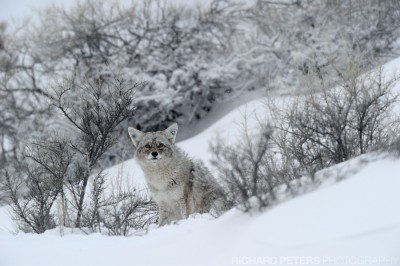
A lone coyote at last light
It would have been superb to photograph the wolves, our target species for the trip, but it just didn’t turn out that way. But it didn’t matter. Just being in Yellowstone at this time of year is a privilege and we had a truly incredible time. The scenery is breathtaking and being parked on a road side high up, looking out over the frozen valleys below as steam from the geysers rise up and fill the air is just jaw dropping and a sight I’ll never forget. The landscape feels almost prehistoric and serves as a reminder that what you’re actually driving about on is a super volcano that’s well overdue an eruption…I just hope it doesn’t do so before I get to go back and finally photograph the elusive wolves of Yellowstone in winter.
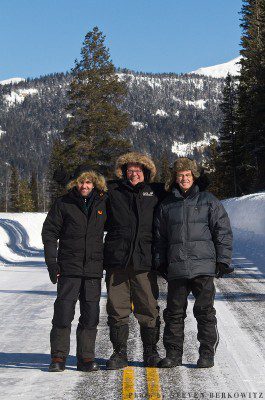
Myself, Rene and Hans.
Don’t forget, if you liked this final part of the trip report, to check out Part One and Part Two as well as view all my other Yellowstone blog articles here.








